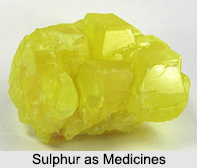 Sulphur and sulphur containing compounds are one of the oldest antimicrobial substances in clinical use. 4 varieties of sulphur are mentioned by Sanskrit writers, namely, red, yellow, white and black. Of these the red and black are not now available. The yellow variety or vitreous sulphur is called "amla-sar", because its semi-transparent crystals resemble the translucent ripe fruits of the Amalaki or Amla (Phyllanthus emblica). It is preferred for internal use in combination with mercury. The white variety or ordinary roll sulphur is inferior to yellow, and used for external application in skin diseases.
Sulphur and sulphur containing compounds are one of the oldest antimicrobial substances in clinical use. 4 varieties of sulphur are mentioned by Sanskrit writers, namely, red, yellow, white and black. Of these the red and black are not now available. The yellow variety or vitreous sulphur is called "amla-sar", because its semi-transparent crystals resemble the translucent ripe fruits of the Amalaki or Amla (Phyllanthus emblica). It is preferred for internal use in combination with mercury. The white variety or ordinary roll sulphur is inferior to yellow, and used for external application in skin diseases.
Processing of Sulphur
Sulphur is purified by being washed in milk. It is first dissolved in an iron ladle smeared with butter and then gradually poured into a basin of milk. When cool and solidified it is fit for use.
Benefits of Sulphur
Sulphur is described as of bitter, astringent taste, with a peculiar strong smell. It increases bile, acts as a laxative and alterative, and is useful in skin diseases, rheumatism, consumption, enlarged spleen etc. In combination with mercury it is used in almost all diseases. The circumstance of it"s readily combining with and fixing metallic mercury, has led to its extensive use in combination with that metal.
Dose of Sulphur in Medicine
In skin diseases, sulphur is used both internally and externally. Internally it is given with milk or in the shape of a sulphurated butter, prepared from milk boiled with the addition of sulphur. The butter thus obtained is called "Gandha Taila", and is taken internally and applied externally on skin diseases.
Sulphur and yavakshara mixed with mustard oil, is applied in pityriasis psoriasis etc. Sulphur enters into the composition of a large number of applications for skin diseases, the following is an example.
Adityapaka Taila: Take sesamum oil 4 seers, madder, the three myrobalans, lac, turmeric, orpiment, realgar and sulphur equal parts, in all 1 seer. Mix and expose to the sun. This oil is useful in eczema, scabies, etc.
In rheumatism it is used in combination with bdellium, as in the following, called Sinhanada guggulu. Take sulphur 8 tolas, bdellium 8 tolas, decoction of the three myrobalans 72 tolas, castor oil 32 tolas, mix and boil together in an iron vessel till reduced to the consistence of a confection. Dose should be about one drachm twice daily. It is useful in chronic rheumatism, lameness, cough, asthma and skin diseases.




















